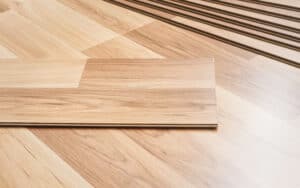
Roofing can be a dangerous job.
You’re up high in the air and usually working on a sloped surface.
In addition to putting a lot of strain on your legs, the sloped surface also makes it easier to fall.
One easy way to prevent accidents is to install a roof jack.
If you’ve never used a roof jack before, then you may wonder what they are.
What Is A Roof Jack?

A roof jack is a flat platform that roofers use to stand on a roof.
They’re particularly useful for sloped or steep roofs.
Walking on a roof without any support is dangerous.
All it takes is one wrong step or a step on a slippery patch to slide down the roof and fall off.
If you’re lucky enough not to be killed, you can still seriously injure yourself in a fall.
To avoid falling from the roof, a roof jack is an extremely helpful tool.
They’re temporary jacks, too, so you don’t have to leave planks on the roof when you’re finished with your roofing services.
You can even attach a ladder to a roof jack to give yourself more room to work on the roof without having to install several roof jacks.
Roof jacks can also decrease the amount of strain you put on your feet and legs.
Since you’re standing flat instead of at an angle, you’re not straining your muscles.
Roof jacks are useful tools for helping roofers stand on a roof.
How Much Weight Can Roof Jacks Hold?

The amount of weight that a roof jack can hold largely comes down to the specific jack used.
However, some roof jacks can hold up to as much as 2,600 pounds.
As such, you can have several workers standing on the same jack at the same time.
You can also put equipment on the jack without having to worry about it breaking.
That said, while the jack might support a lot of weight, the actual flat surface might not.
For example, if the jack doesn’t come with a flat surface, then you might need to provide your own.
In this case, some roofers will use a plank of wood to act as the surface.
They’ll usually opt for a 2×8 or a 2×10.
While this type of plank is usually good at supporting weight, there’s always a chance that it might break or splinter if too much weight is on it.
As such, it’s good practice to determine how much weight the roof jack can hold and how much the flat surface can hold prior to setting it up on a roof.
If you have a roof jack that comes with a flat surface, you can usually trust the maximum amount of weight the manufacturer suggests.
Roof jacks can typically support a lot of weight, but you’ll want to check the specific product to ensure you’re not exceeding the weight limit.
How Do You Install A Roof Jack?

If you have an impending roofing job or you just want to inspect your roof, then you may wonder how you can install a roof jack.
The first step is to obviously buy a roof jack that suits your needs.
If it doesn’t come with a flat surface to stand on, then you’ll want to get either a 2×8 or 2×10 wooden plank, too.
Once you have what you need, you can follow these steps to install your roof jack safely.
1. Attach Jack To Rafter

The first step is to locate the rafters beneath your roof.
This is the most secure place to attach your roof jack.
If you attach it elsewhere, then there’s a chance that the attachment won’t be strong enough.
When you step on the flat surface, the jack might pull up from the nails, and you’ll fall.
As such, you’ll first need to locate the rafters.
An easy way to find the rafters is to look for the sheathing nails.
When installing a roof, the roofers will nail through the underlayment to the rafter.
If you can find the sheathing nails, then you have found the rafter.
After finding the rafter, you’ll need to nail the jack into the rafter.
You’ll want to use 16d nails.
Roofing nails won’t suffice in this case.
With your jack attached to the rafters, you have strong support for your plank.
2. Put Plank Into Jack And Secure It

If your jack doesn’t come with some sort of plank, then you’ll need to buy one yourself.
You can easily obtain a 2×8 or 2×10 from any local hardware store.
Once you have your plank, you need to set it atop the jack.
The jack will also have a part that fits into the edge of the plank.
Screw this part of the jack into the plank.
You should notice that your plank overhangs the jack a bit.
That’s expected, and the overhang should usually be around six inches on each side.
As long as you secure your plank to the jack, stepping on the edges shouldn’t make it topple off the jack.
If you’re only working on a single part of your roof, then at this point, you’re ready to climb onto the plank and start working.
However, if you plan on accessing areas that are higher up on the roof, then you’ll need to complete one more step.
3. Add Ladder To Jack

In most cases, you’ll need to reach a few areas of the roof.
Instead of installing and removing your jack over and over, it’s better to use a ladder with your jack.
That way, you can access the higher parts of the roof without having to move the jack.
It can save you a lot of time.
The best way to use a ladder with a roof jack is to make it from scratch.
You’ll want to use 2x4s and 1x4s to construct your ladder.
The exact amount of length you’ll need depends on how high you need to climb.
Once you’ve built your makeshift ladder, all you need to do is rest it against the roof jack plank.
You’ll want to place it in such a way that the ladder doesn’t have the chance of slipping underneath the plank.
Otherwise, you might slide down and fall.
With the ladder in place, you can now access more of the roof without having to undo your jack.
4. Remove The Roof Jack

Once you’re finished with your roofing services or inspection, you may wonder how to remove your roof jack.
The process is as simple as installing it.
First, you’ll want to remove the ladder if you used one.
You can simply toss it down or slowly move it down to the ground.
Then you’ll want to remove the plank from the jack and set it down on the ground as well.
To remove the jack, you’ll first need to take a hammer and tap up on the jack.
This should remove the jack from the nails.
You can then carry the jack back down to the ground.
When it comes to the jack nails, you have a few options for removal.
You can use a flat pry bar to pound the nails down into the roof.
You can also lift the nails.
You should only lift the nails if the tab is flexible enough for you to do so.
If you leave holes behind, then be sure to patch them before you finish the job.



Leave a Reply